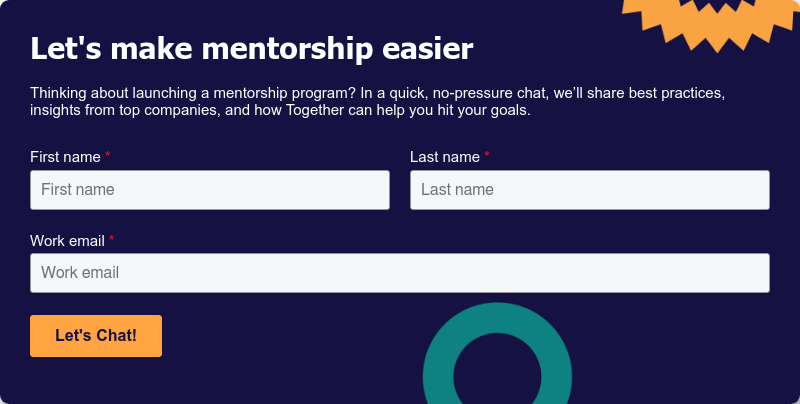A workplace mentoring program can have a big impact on your organization—improving retention, employee engagement, inclusion, and more.
When getting your mentorship program started, using an employee mentorship program template that has already been tested and approved by other enterprises is a surefire way to get your program off the ground quickly and successfully.
At Together, we’ve helped hundreds of enterprise organizations—like Randstad, Kellogg’s, and First Horizon—plan and launch their mentorship programs. We’ve taken our experience and distilled it into a 6-step mentor program outline that you can leverage to bring your own mentorship initiatives to life. Read on, or download this mentorship program template PDF.
👋 P.S. Thinking about launching a mentorship program? Book a quick, low-pressure chat with us to learn best practices, insights from top companies, and how Together can help you build a thriving mentorship culture.
1. Planning your mentoring program
To get the most out of your mentorship program, the first step is to take a step back and define your goals and objectives. What do you want this program to achieve? What business needs can mentorship help uniquely solve? How will you structure your program to meet these goals?
Decide on the goal of the mentorship program
On the surface, all mentorship programs look more or less the same—pairing employees to progress their personal and professional growth. But the goals of your program will ultimately impact other steps in building your program, such as how you will structure your program, and who will participate.
Common goals for mentoring programs include:
- Developing emerging leaders
- Reinforcing employee training
- Onboarding employees faster
- Promoting diversity, equity, inclusion, and belonging
- Supporting employee career development
- Fostering connections between employees in remote or hybrid workplaces
- Aiding succession planning and developing high-potential employees
- Improving company culture
- Increasing employee retention
- Supporting an employer brand that prioritizes the growth and development of employees
Once you better understand the goal of your mentorship program, you can then decide on the program’s structure.
Determine how you will structure your program
There are five common ways to structure a mentoring program. They are:
- Traditional 1-on-1 mentoring: Pairs senior employees with less experienced ones.
- Group mentoring: A mentor takes on several mentees simultaneously, and they learn together.
- Peer mentoring: Colleagues at similar stages in their career learn from one another.
- Reverse mentoring: A more junior employee mentors someone more senior than them.
- Flash mentoring: Mentors and mentees only meet once or twice instead of having recurring meetings, focusing on breadth rather than depth of relationships.
You will also want to determine if your program will be evergreen or cohort-based. Evergreen programs run continuously, and allow participants to opt in or out at their own determination. Cohort programs run for a fixed length of time, like a 6-month program.
2. Registering employees to be mentors and mentees
Once you’ve laid the groundwork for your program, it’s time to get employees to register. You’ll need to do two things:
- Generate excitement among employees, and
- Collect information on participants to be used during the matching process

Generate excitement for your mentoring program
You can’t force people into a mentorship program; mentorship can only be truly impactful when it’s completely voluntary. But it’s also not enough to send out invitation emails and hope for the best. You can promote your mentorship program by:
- Finding champions: Champions are leaders, managers, or simply those who have a vested interest in seeing their colleagues thrive. They can act as recruiters and ambassadors of your program.
- Hosting events: Events like a program kickoff, office hours, or a graduation ceremony at the end of a program can help raise awareness, build enthusiasm, and engage participants on a deeper level.
- Sending mass communications: Use tailored campaigns, multiple communications, and multiple channels to help get the word out.
- Focusing on the benefits of mentorship: Employees will be more interested in joining if they see clear opportunities to grow their skills or career prospects.
- Getting leadership on board: Ask company executives to promote the program. Perhaps the CEO can write a brief letter to employees to encourage participation. They may even be a mentor themselves.
Collect participant information
To effectively match mentors and mentees, you’ll need to get some information on participants, first. A mentoring platform like Together automates this process. You can also use the following registration questions to ensure you have enough information on each mentor and mentee.
Profile questions
- How many years have you spent in your professional career to date?
- How many years have you spent in your current role to date?
- What is your current professional discipline?
- What other professional disciplines are you interested in learning more about or prefer your mentor to be from?
- What other professional disciplines/functions do you have experience in, either here or at other employers?
Skill questions
- [Soft skills] Which skills are you looking to grow and develop through this program?
- [Soft skills] Which skills are your greatest strengths, which you can mentor on?
- [Goals] Which goals do you hope to achieve through this program?
- [Goals] Which goals or accomplishments have you achieved in the past, which you can mentor on?
Experiences
- Describe any experiences or learnings you are hoping to get from this mentoring program.
- Describe any experiences or topics you can help with as part of this mentoring program.
⭐Here’s a cheat sheet of registration questions to ask mentors and mentees.
3. Matching mentors and mentees
The foundation of a successful mentoring program is the mentor-mentee relationship. There are certain qualities that mentors and mentees should have to build a successful mentoring relationship.
Mentees should:
- Be willing to learn and grow but also to teach or share their knowledge with mentors in return.
- Have an open mind and behave respectfully towards their mentor.
- Build trust with their mentor so that they both feel comfortable with each other.
- Cultivate a positive experience by being reliable, hard-working, and showing initiative.
Mentors should:
- Be a good role model. They should be professionals that act with integrity at all times.
- Be willing to share their knowledge and expertise with their mentee.
- Be individuals that regularly set and meet professional and personal goals.
- Love what they do and be enthusiastic about sharing their passion with others.
- Offer guidance and feedback to mentees with empathy and wisdom.
4. Scheduling mentoring sessions
Ensuring that mentors and mentees are meeting on a regular cadence is critical to ensuring that participants are getting the most out of mentorship. We recommend that participants meet once a month.
Mentorship software (like the Together platform) can integrate with employees’ calendars, enabling participants to schedule sessions seamlessly and receive reminders as they approach.

5. Supporting mentoring relationships
Once mentors and mentees are paired, your job as the program manager isn’t over. Help your mentors and mentees get started by providing them with resources like articles, TED talks, discussion topics, and some sample questions to break the ice.
Together’s mentorship platform offers participants template agendas that they can use. We’ve found that templated resources are a useful way to help mentor-mentee relationships begin building rapport.
Encourage mentoring participants to create development plans with each other. Having some ground rules can help guide the mentorship relationship and create appropriate boundaries.
6. Reporting on your mentoring program
You can’t improve what you don’t measure; reporting on key metrics related to your mentorship program is critical to ensuring that it’s meeting the goals that you initially set out to achieve. Some metrics to track include:
- Registration
- Pairing
- Session reports
- Skill and goal reports
Let’s dive into each in more detail.
Registration rates
Regardless of whether or not you leverage mentoring software, you’ll need to keep track of some information on your registrants. By this, we mean their departments, titles, level of seniority, experience, and skills they hope to develop.
With Together’s mentoring platform, you’ll get the following information in an automatically generated registration report:
- An overview of the number of mentors and mentees
- How many mentees that mentors have listed that they can take on at the same time (their mentoring capacity)
- Registration by day
- Feedback from registration questions
Matching success
Program managers need to keep a close eye on the quality of their mentor-mentee matches. You can do this by surveying participants on how they feel about their pairing. Empowering your mentees to have a say in who mentors them generally helps improve pairing sentiment, because mentees are more invested in the relationship.
Session scores
One of the best ways to measure your workplace mentoring program is by asking for feedback from those involved. You can gather this information through surveys, either at the end of the program, or periodically throughout it. Here are some survey questions you can include:
- How have you felt about your growth throughout the program?
- What skills have you been developing?
- How has your relationship with your mentor or mentee been?
- Would you recommend this program to your colleagues?
- Would you sign up for another mentoring program if you had the opportunity?
Skill and goal development
Your program needs to include mentors that have the skills mentees want to develop. This leads to compatibility between mentors and mentees. The skill and goal report provides this information.
Program managers can see what’s discussed most often in each meeting. In the image below, for example, this mentoring program has a focus on innovative thinking and team building. You can use this information to inform future mentoring programs and what their focus should be on.

Examples of this mentoring program template in action
At Together, we’ve used this mentorship program outline to help enterprise companies across North America launch their own mentorship initiatives. Here are some examples of successful professional mentoring programs launched using this framework:
Randstad’s leadership development mentoring program
Randstad, a multinational human resources consulting firm, initially used manual methods for mentor matching, requiring HR managers to spend hours comparing employee profiles. As they scaled their program, this approach became unsustainable.
By using Together’s platform to expand mentoring opportunities without increasing the workload for program administrators, Randstad saw a 49% reduction in employee turnover—an average savings of $2,800 per participant per year in retention.
Avison Young’s mentorship program for women
Avison Young, a commercial real estate firm, launched a company mentorship program to improve diversity, equity, inclusion, and belonging, particularly in leadership roles. Their focus was on advancing women into senior positions.
With Together, Avison Young paired over 550 participants, and the average rating for their mentoring pair was 3.97/4. Additionally, 98% of participants rated the program as satisfactory or very satisfactory.
Cooley’s CAMP program for accelerating onboarding
Cooley, a global law firm with over 1,500 lawyers, designed the Cooley Academy Mentoring Program (CAMP) to onboard new attorneys and prepare them quickly for their roles. By connecting new hires with experienced colleagues, the program provided a robust support system, helping new employees become competent in their roles faster.
As part of the experience, Cooley introduced the “Cooley Mentoring Competition” to strengthen existing mentoring relationships and build new connections among colleagues in a fun and engaging way. If you're looking for a new employee mentoring program template, Cooley's approach demonstrates the power of incorporating creativity and friendly competition into mentoring programs to boost engagement.
Get started using this mentorship program template
By following the steps of this mentorship plan template, you’ll build a program that drives positive employee experiences for both mentors and mentees.
Together can automate this mentoring framework template for you, scaling mentorship across your entire organization. Speak with an expert today to get started.



.svg)




.svg)

